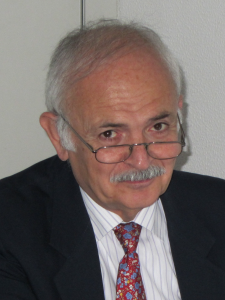 |
Metin Demiralp collaborated with the Prof. Herschel A. Rabitz’s group at Princeton University (NJ, USA) at summer and winter semester breaks during the period 1985–2003 after his 14 month long postdoctoral visit to the same group in 1979–1980. He was also in collaboration with a neuroscience group at the Psychology Department in the University of Michigan at Ann Arbour in three years around 2010 (with certain publications in journals and proceedings). Metin Demiralp has more than 100 papers in well known and prestigious scientific journals, and, more than 260 contributions to the proceedings of various international conferences. He gave many invited talks in various prestigious scientific meetings and academic institutions. For further information the above given web address can be visited. The important recent foci in research areas of Metin Demiralp can be roughly listed as follows: Probabilistic Evolution Method in Explicit ODE Solutions and in Quantum and Liouville Mechanics, Fluctuation Expansions in Matrix Representations, High Dimensional Model Representations, Space Extension Methods, Data Processing via Multivariate Analytical Tools, Multivariate Numerical Integration via New Efficient Approaches, Matrix Decompositions, Multiway Array Decompositions, Enhanced Multivariate Product Representations, Quantum Optimal Control. Metin Demiralp has been officially retired on May 4th 2015 due to age limitation in Turkey state universities. However, he is still an active and productive scientist and occupying a post-retirement position like emeritus professor in his same institution at the moment. He has same group as before, PhD and MS students in the computational science and engineering program and teaching sophisticated graduate courses presently. |
Space Extension Conceptuality and the Recent Status of Probabilistic Evolution Theory (PREVTH)
Abstract:
Probabilistic Evolution Theory has been developed in Group for Science and Methods of Computing (G4S&MC, Demiralp group) studies especially in the last decade. It has been constructed from scratch for the solution of explicit ordinary differential equations, in a limited form for one unknown ODEs at the beginning. The use of Kronecker products and powers has opened the gates to the solution of more than one unknown including ODEs pretty soon. This has enabled the conversion of the considered set of ODEs to a denumerable infinite and homogeneous linear vector ODE with constant denumerable infinite matrix coefficient in such a way that this coefficient matrix was in upper Hessenberg form at its most complicated form. This was not the most desired form to get a rather uncomplicated recursion to find the solution.
Space extension concept has been used in various problems in different formats to get the solution or to facilitate the obtention of the solution to focused ODEs. The use of space extension in PREVTH aims at the tridiagonalization of the abovementioned coefficient matrix and it is accomplished when the right hand side functions of the ODEs at the focus are permitting us to get this success. Many practically encountered system allow us to do so and tridiagonality is obtained.
Even tridiagonality does not help pretty much to get the solution and urges us to get rid of lower-closest-neighbor of main diagonal. To this end, another space extension we have called “Constancy Adding Space Extension (CASE)” has been brought to scene in our group studies. CASE does not remove the closest lower neighbor of main diagonal only, but it enables
us to reshape the main diagonal to be composed of blocks proportional to appropriate identity matrices.
After CASE application the solution of the abovementioned first order linear and homogeneous vector ODE with constant matrix coefficient can be solved by using a two term integral recursion. That solution is composed of Kronecker powers of the system vector with certain rectangular matrices we call “Telescope Matrices” which are cascaded form of “Monocular Matrices”. These Kronecker power series can be converted to a power series of a temporal function (which bends the time axis) with vector coefficients. Quite recently a recursion has been constructed amongst these vector coefficients. This has
been one of latest revolutionary steps in the development of PREVTH.
What we have told above has been for the conical PREVTH where the right hand side vector function of the vector ODE is aimed to be put into conical form (a second degree multinomial). Recent works of our group brought the birth of a new version of PREVTH where we have no longer insisted on the conicality. We have assumed that the right hand side vector is a multinomial and we have sought the possibility of converting this multinomiality to a single monomial with the degree of multinomial. We have discovered that CASE has the capability of converting any Kronecker power to another Kronecker power. This has been our chance to get the single monomiality in PREVTH and we have also been able to find the single monomial PREVTH solution through a two stage procedure which has been based on conical PREVTH recursion.
This talk will focus on certain milestones in this development, and, try to make clear space extension conceptuality together with the recent status of the Probabilistic Evolution Theory (PREVTH).